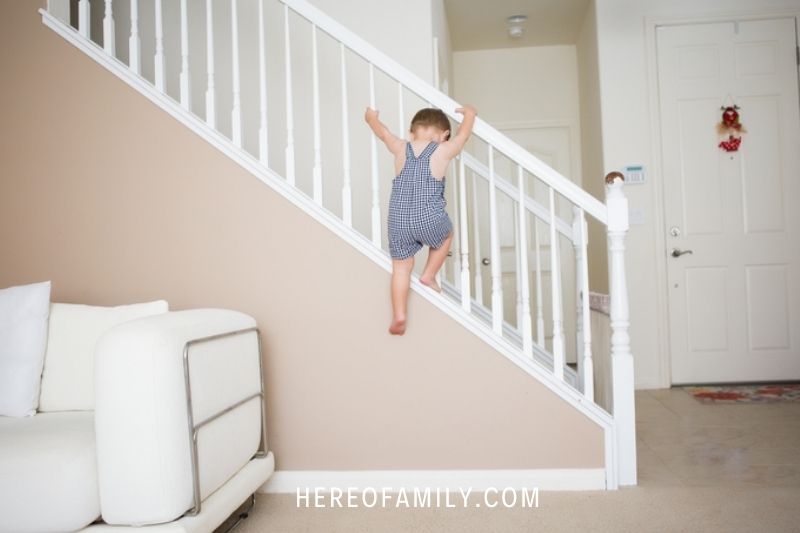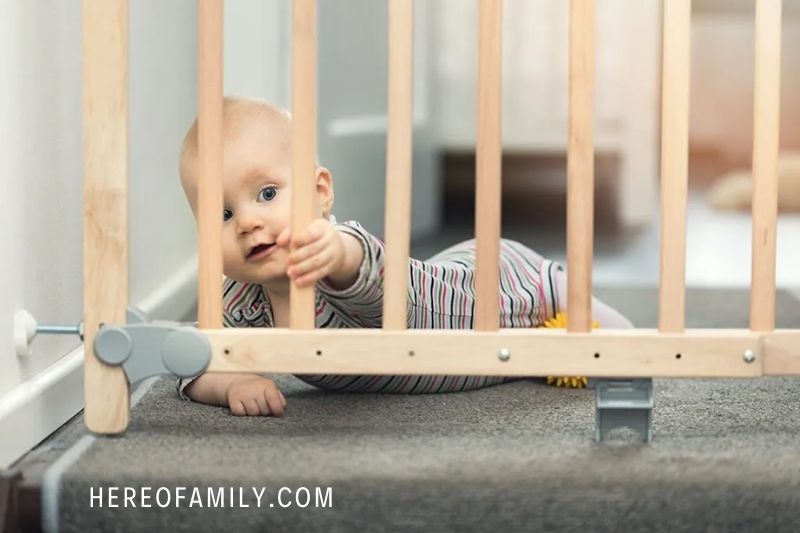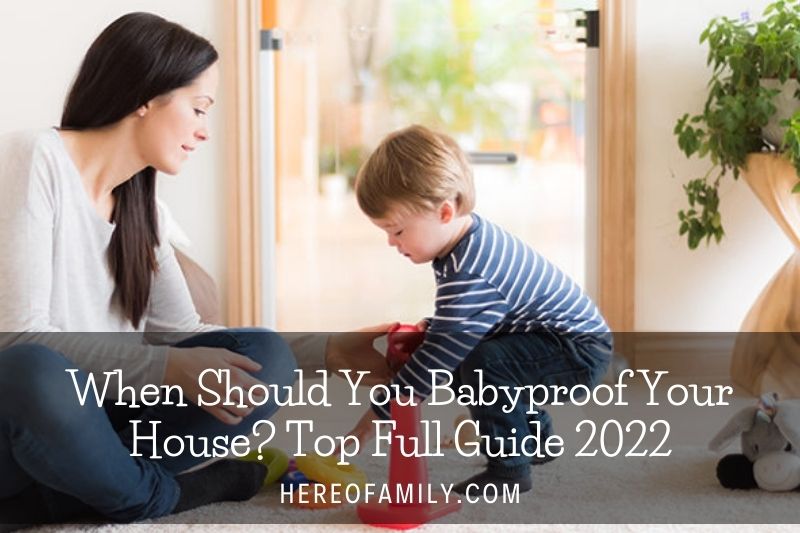If you have a baby or are expecting one, you may be wondering when should you babyproof your house. While there is no definitive answer, there are some general guidelines you can follow.
For example, you may want to start babyproofing as soon as your baby starts crawling or when they start pulling up on furniture. Additionally, it would help if you considered any potential hazards in your home, such as staircases, sharp corners, or electrical outlets.
Contents
When Should You Babyproof Your House

Baby proofing may assist you in preventing the majority of injuries that occur to children at home. The majority of these mishaps are inadvertent. It may result in the death of a child in certain situations. As a parent, you will notice that your children are exposed to various hazards as they crawl about. This implies that you should babyproof your house before your child starts crawling.
While you should baby-proof your house before your kid begins crawling, it is more beneficial to consider this before birth. Before bringing your newborn home, make sure the crib and other furnishings surrounding the infant are safe. Although most cribs are safe when purchased, check to see whether the crib fulfills regulatory safety regulations.
Make certain that anything that will come into contact with your kid is safe. Remove any blankets, pillows, and plush animals from the crib. This may assist save your infant from suffocating in their bed. Install carbon monoxide and smoke detectors in the baby’s room and the hallway. If you already have them, make sure they are operational before bringing your baby home.
It is never too soon to begin baby-proofing your home. The threats exist even before your infant begins to crawl or walk. You may crawl about yourself to obtain a sense of the dangers your infant experiences while crawling.
Things To Use In Baby Proofing

Kid proofing is using various gadgets throughout the home to safeguard your baby from danger. Among them are some of the following:
- Locks. Lock up your drawers.
- Latches for safety. On doors, freezer doors, and cabinets, use safety locks.
- Bumpers. Bumpers protect your furniture’s sharp edges and corners.
- Window treatments. To prevent accidental strangulation, use cordless window coverings.
- Anchors. Anchors may assist prevent your infant from dragging down heavy pieces of furniture (TVs, bookshelves, or other devices) that may fall on them.
- Covers for knobs. Doorknob coverings prevent your kid from twisting the knobs.
- Covers for outlets. Outlet covers or plugs protect electrical sockets while they are not in use.
Baby Proofing The Home
The Kitchen
If your house is anything like mine (or, to be honest, every home I’ve seen on HGTV in the last few years), you almost certainly have an open-concept kitchen. This means that even if you’re in the living room, your mobile kid may easily go to the cupboards or pantry, and a standard entryway gate isn’t an option.
There’s no need to fear, but contemporary childproof cabinet locks are an excellent investment. The previous tenants of my apartment utilized stick-on plastic latch locks that almost destroyed the wood on the cabinet doors. We had to yank them out and begin over.
Avoid that mess by opting for magnetic locks that may be installed on the inside of cabinets while still providing the same safety measures and quick adult access. Consider using stove knob covers to keep your kid from accidentally turning on the burners once he’s standing.
While it is normal to store cleaning materials beneath the kitchen sink, Dr. Johnson-Arbor recommends finding a new location for the high and out of reach. “This is particularly true during the COVID-19 epidemic since many individuals keep cleaning materials on hand. We may also be utilizing cleaning products that we haven’t used in a long time,” she explains.
“Some cleaning products have colorful labeling that appeals to young children; disinfection solutions may have citrus aromas or similar perfumes, and young children may be unaware that things that smell pleasant may also be harmful. Keep these containers out of reach of small children by placing them somewhere they can’t get to by climbing or crawling.”
She also advises parents to avoid shifting cleaning supplies into unlabeled containers, even if they seem more organized or save room. “This can be highly harmful since small children and other household members may be unaware of what is truly included in the container.”
Wood advises avoiding glass top tables for safety and aesthetic reasons, since they might be less sturdy than wood or metal ones, and avoiding decorating the area with a mat beneath the table you most often dine at. “You don’t want a rug beneath the dining room table in the early years of life because of spills or accidents,” she advises. “That rug will need a great deal of cleaning and care—if you have hard flooring, keep them uncovered until you have tamed eaters.”
Checklist for Kitchen Babyproofing:
- Childproof cabinet locks and drawer locks for things that are hazardous to children (once your baby can climb, he can reach anything)
- Covers for stove knobs to prevent the infant from turning on the burners.
- Rug anti-slip pads
Living Room
Falls and accidents with sharp-edged furniture provide the greatest danger in this space. If you must deal with the corners, add some stick-on corner cards. You might also consider some fashionable furniture alternatives on the market, such as spherical coffee tables or soft ottomans that can be used as tables, particularly if they include storage, recommends Wood.
Check the washing codes and search for high-performance upholstery suitable for daily use and wears and cleans well when dealing with textiles for sofas or chairs. “Other choices include slipcovers,” Wood explains. “Some can be washed and dried in your machine, or you can take them to the dry cleaners, and they will come back looking like new.”
Look for childproof covers for any electrical outlets or GFIs near the ground, and if you have blinds or shades on windows, make sure they are cordless since cables have been designated a strangling threat.
Checklist for Babyproofing the Living Room:
- Corner stickers for furniture with sharp edges
- Child-resistant outlet covers
- Blinds with no cables (the cords on blinds and curtains are strangling hazards)
The Nursery
According to Wood, the most crucial consideration in this space is functional. “Have enough storage for everything in there if this is your primary room for caring for your infant,” she advises. “I like dressers that have removable tops. There is safety, and it is intended for this reason. When you no longer need a changing table, remove the topper, and you have a dresser that can grow with them.”
Avoid hanging anything immediately above the crib and changing the table that the baby may grip and pull while decorating the room. “As much as you may desire a beautifully designed nursery with a gallery wall behind the cot,” adds Wood, “it is not the safest.”
“Consider painting an accent wall, using wallpaper, or perhaps a wall decal instead. These are fantastic since they cannot be moved while still providing an attractive feature.”
Checklist for Babyproofing a Nursery:
- To cushion falls, use a thick piece of carpet or a rug.
- A secure toy box, preferably an open bin (boxes with heavy lids can be dangerous for a baby)
- Replacement bulbs and UL-listed nightlights
- Finger-pinch protectors for door hinges
Bathroom and Laundry Room
Because this is where you store your prescriptions and cleaning supplies, it needs extra babyproofing care. “Because adults are older and larger than small children, we don’t often think like children regarding poison avoidance and childproofing,” Dr. Johnson-Arbor explains.
She claims that although ordinary home goods such as laundry pods, hand sanitizer, cleaning wipes, and appealing soaps may be alluring to small children, they are harmful if consumed.
“Keep all pharmaceuticals (both prescription and over-the-counter) out of the reach of children. Although child-resistant packaging is beneficial, toddlers are resourceful and may be able to open child-resistant pill bottles.”
Checklist for Babyproofing the Bathroom:
- Locks for medicine cabinets
- A toilet security lock
- A thermometer to verify that the bathwater for your infant is at a safe temperature.
Some relevant posts:
- Does Baby Powder Cause Cancer? Complete Guide 2023
- Best Baby Breathing Monitor: Keep Baby Safe and Sound 2023
- Is Wifi Safe For Babies? Top Full Guide 2023
- How To Help Choking Baby? Top Full Guide [2022]
- Check Neighborhood Safety 2023: Top Full Guide
- Is Daycare Safe For Infants 2023? Top Full Options Here!
- Where To Put Baby Monitor? Top Full Guide [2022]
FAQ
Should you childproof your home?
According to the Consumer Product Safety Commission, approximately 90 children drown inside American homes each year, making it critical to keep bathroom doors closed and toilet covers secured with child-proof locks.
Why do you Babyproof your house?
Putting up barriers, such as a baby gate, to keep your youngster safe from risks like stairs or fires. Locking harmful items (such as home chemicals and medications) away or relocating them out of reach. Securing heavy furniture, such as cabinets and TV stands, prevents tipping.
What is the best way to childproof your home?
Your Child-Proof Residence
Install smoke detectors on each level of your house, particularly near bedrooms. If you use gas or oil heat or have an attached garage, place carbon monoxide detectors near sleeping quarters. Cover electrical outlets with covers. Cushions should be placed in the corners of the furniture.
Conclusion
As soon as your baby starts crawling, it’s time to start thinking about babyproofing your home. There are a lot of potential hazards in any home, but with a few simple precautions, you can make your home safe for your little one.
